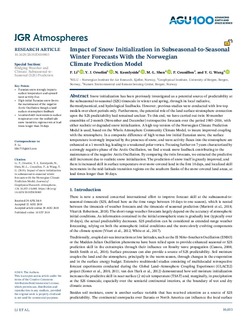| dc.description.abstract | Snow initialization has been previously investigated as a potential source of predictability atthe subseasonal‐to‐seasonal (S2S) timescale in winter and spring, through its local radiative,thermodynamical, and hydrological feedbacks. However, previous studies were conducted with low‐topmodels over short periods only. Furthermore, the potential role of the land surface‐stratosphere connectionupon the S2S predictability had remained unclear. To this end, we have carried out twin 30‐memberensembles of 2‐month (November and December) retrospective forecasts over the period 1985–2016, witheither realistic or degraded snow initialization. A high‐top version of the Norwegian Climate PredictionModel is used, based on the Whole Atmosphere Community Climate Model, to insure improved couplingwith the stratosphere. In a composite difference of high versus low initial Eurasian snow, the surfacetemperature is strongly impacted by the presence of snow, and wave activityfluxes into the stratosphere areenhanced at a 1‐month lag, leading to a weakened polar vortex. Focusing further on 7 years characterized bya strongly negative phase of the Arctic Oscillation, wefind a weak snow feedback contributing to themaintenance of the negative Arctic Oscillation. By comparing the twin forecasts, we extracted the predictiveskill increment due to realistic snow initialization. The prediction of snow itself is greatly improved, andthere is increased skill in surface temperature over snow‐covered land in thefirst 10 days, and localized skillincrements in the mid‐latitude transition regions on the southernflanks of the snow‐covered land areas, atlead times longer than 30 days. | nb_NO |

